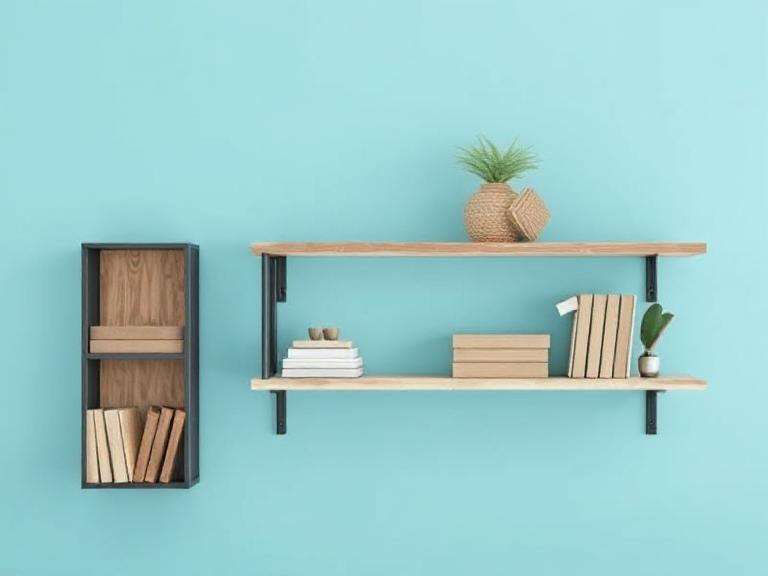Table of Contents
- Introduction
-
Understanding Plywood vs. Solid Wood
- 2.1 What is Plywood?
- 2.2 What is Solid Wood?
- Advantages of Plywood for Shelves
- Advantages of Solid Wood for Shelves
-
Factors to Consider When Choosing Between Plywood and Solid Wood
- 5.1 Durability and Strength
- 5.2 Cost
- 5.3 Aesthetic Appeal
- 5.4 Environmental Impact
- 5.5 Ease of Maintenance
- Applications of Plywood and Solid Wood Shelves
- Steel Power Shelving: An Alternative to Wood Shelves
- Frequently Asked Questions (FAQs)
- Conclusion
1. Introduction
When designing shelving units for your home or office, one of the most crucial decisions you'll face is whether to use plywood or solid wood. Both materials offer their own advantages and disadvantages, making the decision heavily reliant on the purpose of the shelves, aesthetic preferences, and budget. Understanding the characteristics of each material can help you make an informed choice that best suits your needs.
In this article, we’ll compare plywood and solid wood, exploring the benefits of each material for shelves. We’ll also discuss factors such as durability, cost, and aesthetic appeal. For those looking for versatile shelving solutions, we will introduce Steel Power Shelving, a top shelving supplier based in Brisbane that specializes in durable metal shelving options.

2. Understanding Plywood vs. Solid Wood
Before we dive into the comparison of plywood and solid wood, it’s important to understand the key differences between the two materials.
2.1 What is Plywood?

Plywood is a versatile material made by gluing together multiple thin layers (or plies) of wood veneers. These layers are placed with alternating grain directions to add strength and prevent warping. Plywood is typically manufactured in large sheets and comes in a range of thicknesses and finishes, making it an affordable and practical choice for many shelving applications.
Types of Plywood:
- Softwood Plywood: Made from pine, fir, or spruce, commonly used for general construction and furniture.
- Hardwood Plywood: Made from hardwoods like oak, maple, or birch, typically used for higher-end furniture and cabinetry.
2.2 What is Solid Wood?
Solid wood refers to lumber that comes from a single piece of wood, such as oak, maple, pine, or walnut. Unlike plywood, solid wood is not made by layering veneers. Instead, it is cut directly from trees and is known for its strength, durability, and natural beauty.
Types of Solid Wood:
- Hardwoods: Oak, maple, walnut, cherry, and teak, known for their strength and elegant appearance.
- Softwoods: Pine, cedar, fir, and spruce, typically more affordable and easier to work with.
3. Advantages of Plywood for Shelves
Plywood is a popular choice for many shelving projects due to its unique qualities. Here are some reasons why plywood may be a better option for your shelves:
1. Cost-Effective
Plywood is generally more affordable than solid wood, making it an ideal choice for budget-conscious projects. The manufacturing process of plywood allows for less expensive wood to be used, which drives down the overall cost.
2. Lightweight
Plywood is relatively lighter compared to solid wood, making it easier to transport and install, especially for large shelving units. This can be particularly advantageous for DIY projects or installations where the shelves need to be moved around frequently.
3. Strength and Stability
While plywood is lightweight, it is surprisingly strong and stable. The cross-grain construction of plywood adds strength and reduces the likelihood of warping or cracking over time. High-quality plywood is an excellent option for shelving that needs to carry a fair amount of weight.
4. Versatile Design Options
Plywood can be easily customized in terms of size, shape, and finish. It can be painted, stained, or covered with a veneer to achieve the desired look, offering a variety of aesthetic possibilities.
5. Environmental Considerations
Plywood is considered more sustainable than solid wood since it uses smaller, thinner layers of wood from multiple trees, reducing the environmental impact of logging. Additionally, plywood manufacturers often use fast-growing trees, which helps preserve mature forests.
4. Advantages of Solid Wood for Shelves
While plywood has many benefits, solid wood has its own set of advantages that may make it the preferred choice for certain shelving applications.
1. Durability and Longevity
Solid wood is extremely durable and known for its long-lasting properties. Unlike plywood, which may eventually start to show wear and tear from the layers separating, solid wood can endure for generations. Solid wood shelves can withstand heavy loads without losing their strength, making them ideal for long-term storage.
2. Aesthetic Appeal
Solid wood exudes a timeless, luxurious aesthetic. The natural grain, texture, and unique imperfections of solid wood make it a beautiful addition to any room. Many people choose solid wood for its elegance and its ability to add warmth to the space.
3. Higher Weight Capacity
Because of its solid construction, solid wood typically has a higher weight capacity compared to plywood. If you need shelves to support heavy items like books, electronics, or collectibles, solid wood may be the better option.
4. Natural Material
Solid wood is a 100% natural material, which some people prefer for aesthetic, health, and environmental reasons. It doesn’t contain adhesives or chemicals that are present in plywood, which might be a concern for individuals sensitive to synthetic materials.
5. Customization and Repair
Solid wood can be easily refinished, sanded, and repaired if it gets scratched or damaged. Over time, the beauty of the wood can actually improve, developing a unique patina that adds character. In contrast, once plywood is damaged, it can be harder to restore.
5. Factors to Consider When Choosing Between Plywood and Solid Wood
When deciding whether plywood or solid wood is the right material for your shelves, there are several factors to take into account. Here’s a breakdown of key considerations:
5.1 Durability and Strength
- Solid Wood: Offers superior durability and long-lasting performance. If you need shelving that can withstand heavy loads and years of use, solid wood is the better choice.
- Plywood: Offers great strength for most uses but may not be suitable for extremely heavy items.
5.2 Cost
- Plywood: More affordable and a great option for budget-conscious projects.
- Solid Wood: Generally more expensive due to the cost of the material and manufacturing process.
5.3 Aesthetic Appeal
- Solid Wood: Offers a natural, timeless look that adds warmth and luxury to any space.
- Plywood: Can be customized with veneers or paints, but may not have the same elegant appearance as solid wood.
5.4 Environmental Impact
- Plywood: Typically more sustainable as it uses thinner layers of wood and utilizes faster-growing species.
- Solid Wood: Can have a higher environmental impact if it comes from slow-growing species or poorly managed forests.
5.5 Ease of Maintenance
- Solid Wood: Easier to maintain over the long term with proper care. It can be sanded, refinished, and restored.
- Plywood: May require more careful maintenance, as it can warp or show wear more quickly.
6. Applications of Plywood and Solid Wood Shelves
Each type of wood has its ideal applications, depending on the type of shelving you are planning. Here are some examples:
- Plywood Shelves: Best suited for lightweight storage, display shelves, closet organization, or areas where cost-efficiency is important.
- Solid Wood Shelves: Ideal for long-term storage in areas that require strength and durability, such as bookcases, heavy-duty garage shelving, or fine furniture.
7. Steel Power Shelving: An Alternative to Wood Shelves

While plywood and solid wood are popular choices for shelves, Steel Power Shelving offers a great alternative for those seeking durability, strength, and versatility. Based in Brisbane, Steel Power Shelving specializes in a variety of metal shelving systems, including:
- Metal Shelving: Perfect for high-density storage with a strong, durable frame that can hold heavy items.
- Garage Shelving: Designed to handle the weight and strain of storing tools, boxes, and other garage items.
- Shelving with Pegboard: Ideal for organizing smaller tools and accessories in a clean, efficient manner.
Steel Power Shelving products are designed for maximum durability and longevity, ensuring they will stand up to the test of time in any environment. The shelves are versatile, customizable, and can support heavy loads, making them a superior choice for businesses and home storage needs.
8. Frequently Asked Questions (FAQs)
1. What is the best material for shelves in a high-traffic area?
Solid wood is ideal for high-traffic areas due to its durability and ability to withstand wear and tear. However, if you’re looking for a more affordable solution, Steel Power Shelving offers durable and versatile metal shelving options.
2. Can plywood shelves support heavy items?
Yes, plywood can support heavy items if it is thick enough and properly supported. However, for heavier items, solid wood or metal shelving might be a better option.
3. Which material is more environmentally friendly?
Plywood is generally more sustainable as it uses smaller, thinner layers of wood and can be made from fast-growing trees. Solid wood, especially if sourced from unsustainable forests, can have a higher environmental impact.
9. Conclusion
When it comes to choosing between plywood and solid wood for shelves, both materials offer distinct advantages and can be suitable for different applications. Plywood is more affordable, lightweight, and versatile, making it a great choice for budget-conscious projects, while solid wood provides exceptional durability and a luxurious aesthetic, ideal for high-end applications.
However, if you’re seeking an alternative that combines strength, versatility, and long-lasting durability, consider Steel Power Shelving for all your storage needs. With a range of high-quality metal shelving options, Steel Power Shelving is a trusted supplier that can provide excellent solutions for your shelving requirements.
Tabel of Plywood vs Solid Wood Shelves
| Factor | Plywood | Solid Wood |
|---|---|---|
| Cost | More affordable | More expensive |
| Durability | Suitable for lightweight use | Highly durable and long-lasting |
| Aesthetic Appeal | Customizable with veneers | Elegant, natural appearance |
| Environmental Impact | More sustainable | Potentially higher impact |
| Ease of Maintenance | May wear faster, harder to restore | Easier to maintain, can be refinished |

